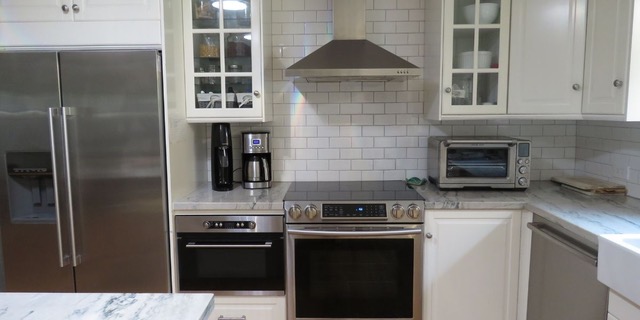Making the Connection: Sustainable Living and Electrifying Everything


When I became interested in “sustainable living” I understood the basics. Use more renewable energy and stop driving gas guzzlers. We traded in our combustion engine car for a Tesla and got solar roof panels. But I was missing one crucial piece of the sustainable living puzzle. Home electrification.
Natural gas still powered our stove, furnace, and dryer. We even replaced our wood burning fireplace with a natural gas fireplace at one point. I was absolutely committed to sustainable living, but I simply did not understand the importance of electrifying everything or the problems with natural gas.
Electrify everything
I look back on that mistake and think, “what was I thinking?” But the concept of electrifying everything wasn’t part of the environmental movement’s message until Vox published The key to tackling climate change: electrify everything, by David Roberts in October 2017. When I read the below quote, all the puzzle pieces connected for me:
“We know, or at least have a pretty good idea, how to get electricity down to zero carbon. There are options: wind, solar, nuclear, hydro, geothermal, and coal or natural gas with carbon capture and sequestration (CCS). There are plenty of disagreements about exactly what mix of those sources will be needed to get us to a carbon-free grid, and what mix of centralized versus distributed resources, and what mix of supply-side versus demand-side solutions — but there’s broad consensus that pathways to fully clean electricity exist,” according to Roberts.
To sum that up for anyone who wants to live more sustainably - the best sustainable living choice is to replace anything that runs on fossil fuels with something that runs on electricity. That means making your next car and home appliance electric. At home, replace your natural gas appliances with electric appliances.
The environmental problem with natural gas
“Natural gas, a fossil fuel, is California’s second-largest source of greenhouse gas (GHG) emissions behind transportation, contributing roughly one-third or more of total GHG emissions,” according to FossilFreeBuildings.org. “One of the most impactful climate policy steps that Silicon Valley cities can take is avoiding natural gas in new buildings, via all-electric, Zero Carbon designs.”
That’s why more and more cities are banning natural gas in new buildings. As I write this there are 51 cities in California that have banned natural gas in new buildings according to the Sierra Club. Other cities across the United States have also passed laws banning natural gas such as Seattle, Washington and Ithaca, New York.
Home electrification
Eco-conscious homeowners are also trying to go all-electric at home. Once I understood it, it became an easy way to look at how to make our home more sustainable. Replace natural gas appliances with electric appliances and use as much clean and renewable energy as possible. But in reality, it can be easier said than done.
“While 100% all-electric is clearly ideal for lowering emissions and increasing energy efficiency and health outcomes, it’s important to understand that electrification can also be an improvement process. Each decision to purchase electric equipment instead of burning fossil fuels onsite produces some if not all of the outlined benefits. And, many key building equipment decisions are made one at a time, as equipment fails and needs to be replaced,” according to the Rate it Green Team, in explaining why building electrification matters for our health, comfort and wallets, in addition to environmental benefits.
This quote really spoke to me. My family and I live in a 1960’s ranch style home in San Jose, California. We’ve been slowly replacing natural gas appliances with electric appliances as old appliances break down. Trying to do it all at once would be a huge undertaking. The wiring is old, and the electrical panel can only handle so much.
When the induction range was installed we also needed additional wiring to carry a heavier current to the induction stove that requires a higher voltage. Eventually we also either need a second electrical panel or a modern one, like the one by Span. We’ve learned that home electrification can quickly go from being a simple concept to being a major project. You touch one part of an old home and it has a ripple effect on the rest, so it’s easy to get overwhelmed. We’ve learned to go piece by piece and appliance by appliance.
Rate It Green, the Massachusetts Clean Energy Center (MassCEC), and others also advocate making a replacement plan in advance for key equipment, so that you can choose your equipment with care, and not more likely get stuck with "what you can get" in an emergency failure situation. Each appliance or major equipment decision can have a greater impact than most people think, since typical equipment has a useful life anywhere from 10 to 30 years, on average, or even more.
Our electric appliances

So far we’ve replaced our natural gas range with an induction oven and our wood burning fireplace with an electric fireplace insert. We also replaced our propane outdoor heater with a radiant heater. A bit more about these products below.
Induction range
When we were first considering replacing the natural gas range with an induction range I wasn’t sure if I would love it. I grew up with a dual range that had natural gas burners on one side and electric burners on the other and I always used the gas burners because it seemed to get hot faster. That may have been the case with old stoves, but with the new induction cooktops everything gets hot so fast. Too fast in the beginning to be honest. I was used to blasting the heat on the natural gas cooktop. The first few times I used the induction cooktop, I burnt the food. Eventually I learned that my ideal setting is medium, not high. Now I only use the highest heat for boiling water. So there’s certainly a learning curve.
We also had to get rid of one or two old pans that didn’t work with the induction cooktop, but most of our pots and pans were compatible. The best way to check if your pans are compatible with an induction cooktop is to stick a magnet to the bottom of the pan. If it sticks, it’s compatible. If not, it won’t work on the induction cooktop.
Then there’s the safety aspect of cooking on the induction cooktop. My kids like to cook, but I was always nervous letting my 8 year old daughter cook on the open flame. Now that we have the induction cooktop I still keep a close eye on her, but I’m not concerned that she’ll catch a sleeve on fire on the open flame.
Finally, the induction cooktop is so easy to clean! This has made clean-up at the end of each meal so much easier. I used to dread having to take the grates off the natural gas cooktop to scrub. With the glass cooktop, I just wipe, spray, wipe again and then I’m done and my kitchen looks sparkly.
The electric fireplace insert
We also have an electric fireplace insert now where the wood burning fireplace used to be, and I like it so much more than the natural gas fireplace. Although the natural gas fireplace heats more of the room, the electric fireplace was significantly less expensive to install. So there’s a trade-off. But if I had to do it all over again, I would absolutely have done an electric fireplace insert where the natural gas fireplace is now. As I think back, I don’t remember there being an electric fireplace option when we looked at fireplace inserts. I didn't know there was an option back then.
The radiant outdoor heater
We’ve also replaced our propane patio heater with a radiant heater and I can’t believe we ever bothered with that old propane heater. It was always empty when we wanted to use it and my hubby would have to run to the store. The radiant heater, on the other hand, is always ready to go. We just plug it in, and we have instant heat. No propane required.
As you can imagine, replacing these appliances can get expensive. But I use two resources to help me find cost efficient products and to determine projects to priorities.
A Pocket Guide to All-Electric Retrofits of Single-Family Homes by FossilFreeBuildings and Redwood Energy is my go to guide for all things home electrification. It includes pricing information as well as contractors that specialize in home electrification in California. Even if you’re not in the Golden State, this guide should be helpful.
Detailed household natural gas and propane end‐use consumption by the EIA.gov is great if you want to nerd out on which natural gas appliance uses the most natural gas. If you have many appliances to update but you have to pick between one or two, this chart can help you determine your natural gas usage based on appliance and your own location.
The need for financial incentives
Electric appliances are getting less expensive, but there are still price barriers that stand in the way of home-owners going all electric. There are also economic benefits according to Saul Griffith at Rewiring America, but we need government incentives.
“If done right, we would create millions of new, good-paying jobs in every zip code, save each household on average between $1,050 to $2,585 per year on its energy bills, and dramatically reduce economy-wide greenhouse gas emissions — all the while enjoying zippier cars and smarter appliances,” according to Household Savings Report: No Place Like Home: Fighting Climate Change (and Saving Money) by Electrifying America’s Households which can be found at RewiringAmerica.com.
I don’t know how long it will take for us to go all-electric at home, but I do know that the rally cry of electrify everything has become my North Star when I write or talk about sustainable living. There’s simply no way around it. A sustainable home is an all-electric home. If you’re interested in following along with our journey, I update Sustainable home improvements: How we’re going electric as we discover new information and electric products.
- Filed Under: Energy
- ( 7267 ) views

Rebecca is a LEED Green Associate, an ISSP Sustainability Associate, and a search marketing consultant for ecopreneurs. She and her family are going all-electric at home and on the road.
- ( 0 ) Ratings
- ( 0 ) Discussions
- ( 0 ) Group Posts
Reply/Leave a Comment (You must be logged in to leave a comment)
Connect with us!
Subscribe to our monthly newsletter:
 Greenbuild Report Out, 2025 Nov 12, 2025
Greenbuild Report Out, 2025 Nov 12, 2025






























Not a Member Yet? Register and Join the Community | Log in